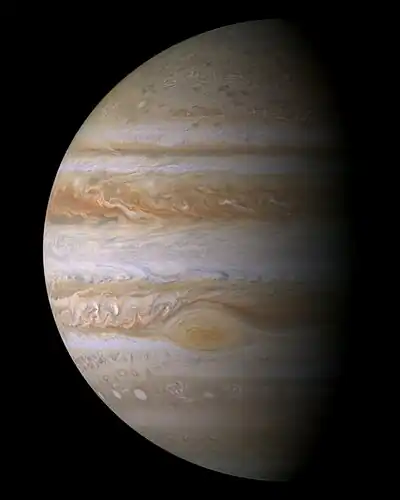 Montage with JEO | |
| Mission type | Europa orbiter |
|---|---|
| Operator | NASA |
| Website | ESA Webpage on Laplace/EJSM |
| Mission duration | cruise period: 6 years (proposed), science period: 3 years (proposed) |
| Spacecraft properties | |
| Launch mass | 1371 kg |
| Start of mission | |
| Launch date | 2020 (proposed) |
| Rocket | Delta IV-H or Atlas V |
| Orbital parameters | |
| Reference system | Europa orbit |
| Inclination | 95°–100° |
| Europa orbiter | |
| Orbital insertion | 2026 (proposed) |
As a part of the defunct Europa Jupiter System Mission – Laplace (EJSM-Laplace), the Jupiter Europa Orbiter (JEO) was a proposed orbiter probe slated for lift-off in 2020 and planned for detailed studies of Jupiter's moons Europa and Io as well as the Jovian magnetosphere.[1] Its main goal would have been to look for evidence of a possible subsurface ocean.[2]
In June 2015, a more economical mission, the Europa Multiple-Flyby Mission (Europa Clipper) was approved by NASA and entered the formulation stage.[3]
See also
- Europa Orbiter (former NASA plan cancelled in 2002).
- Europa Clipper (the next mission plan for Europa, non-nuclear orbiter for Jupiter doing Europa flybys).
- Europa Lander (NASA) (stand-alone mission for NASA Europa Lander) (Note: there was also a concept for a Europa Clipper add-on lander).
References
- ↑ Battersby, Stephen (5 November 2009). "A drop in the bucket is plenty". The National. Retrieved 8 November 2009.
- ↑ Jupiter Europa Orbiter (JEO) Concept Archived 2011-04-26 at the Wayback Machine
 This article incorporates text from this source, which is in the public domain.
This article incorporates text from this source, which is in the public domain. - ↑ Howell, Elizabeth (20 June 2015). "NASA's Europa Mission Approved for Next Development Stage" Space.com. Retrieved 2015-06-21.
This article is issued from Wikipedia. The text is licensed under Creative Commons - Attribution - Sharealike. Additional terms may apply for the media files.

